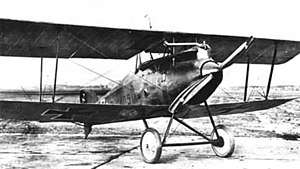Friedrichshafen D.I
The Friedrichshafen D.I (company designation Friedrichshafen FF.46) was a German single-seat fighter plane developed by the Flugzeugbau Friedrichshafen.
| D.I | |
|---|---|
 | |
| Friedrichshafen D.I circa 1917 | |
| Role | Fighter |
| Manufacturer | Flugzeugbau Friedrichshafen |
| First flight | 1917 |
| Status | prototype only |
| Primary user | Luftstreitkräfte |
| Number built | 3 |
| Developed from | Friedrichshafen FF.43 |
Design and development
The Flugzeugbau Friedrichshafen, after having built the FF.43 floatplane, offered unsuccessfully to the Kaiserliche Marine, modified the aircraft to different requirements. The company's technical office intervened marginally on the cell of the original project, essentially removing the tubular structure that connected the two floats and installing in its place a simple landing gear fixed, with the classic configuration of the period, axle rigid rotated front plus sliding pad under the tail. For the rest, the aircraft, which was identified by the company with the initials FF 46, maintained the same engine, the 160 hp (120 kW) Mercedes D.III engine, and the same offensive armament based on a pair of synchronised 7.92 mm (0.312 in) LMG 08/15 Spandau machine guns chambered for the standard cartridge of the period, the 7.92 × 57 mm Mauser, firing through the propeller disc. After submitting the preliminary draft to Idflieg in September 1916, the company obtained an order for three aircraft to be submitted for evaluation tests.[1][2]
The first and second prototype, while maintaining the same velatura biplana at positive scaling, differed due to the different solution in the central link of the wing plane higher than fuselage, where the montantini perpendicular to the first one were substituted with those divaricated in the second one to allow a better visual field to the [pilot aviator], while the two wing planes were connected to each other by a one pair per side of interlocking posts.[1]
The two prototypes supported a series of tests until April 28, 1917, revealing that the aircraft possessed flight characteristics and lower performance than those already in line, so no subsequent supply order was issued and the project was abandoned. There is no definite information on the use of the third prototype, nor has it ever actually been completed.[1]
Specifications
Data from Flugzeugbau Friedrichshafen GmbH[3]
General characteristics
- Crew: 1
- Length: 6.45 m (21 ft 2 in)
- Wingspan: 9.04 m (29 ft 8 in)
- Height: 2.9 m (9 ft 6 in)
- Wing area: 22.7 m2 (244 sq ft)
- Empty weight: 665 kg (1,466 lb)
- Gross weight: 901 kg (1,986 lb)
- Fuel capacity: 63 kg (139 lb)
- Powerplant: 1 × Mercedes D.III 6-cylinder water-cooled in-line piston engine, 120 kW (160 hp)
Performance
Armament
- Guns: 2 × fixed, forward-firing 7.92 mm (0.312 in) LMG 08/15 machine guns
See also
Related lists
References
| Wikimedia Commons has media related to Friedrichshafen 1917 D type. |
- Green, William; Swanborough, Gordon (1994). The Complete Book of Fighters. London: Salamander. pp. 234–235. ISBN 1-85833-777-1.
- "Friedrichshafen D.I". www.airwar.ru.
- Kober, Theodor von; Borzutzki, Siegfried. Flugzeugbau Friedrichshafen GmbH (in German) (1. Aufl ed.). Burbach. p. 144. ISBN 978-3927513600.
Further reading
- The Illustrated Encyclopedia of Aircraft (Part Work 1982–1985). Orbis Publishing.